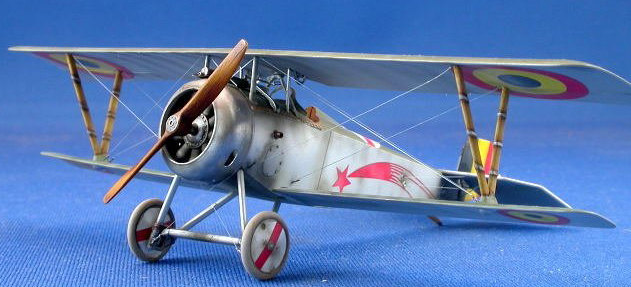
Eduard 1/72 Nieuport 23
| KIT #: | 7073 |
| PRICE: | $24.95 MSRP |
| DECALS: | Four options |
| REVIEWER: | Roger Fabrocini (no e-mail addy provided) |
| NOTES: |

| HISTORY |
The Nieuport 17 and Nieuport 23 fighters were effectively the “second series” of the classic Nieuport sesquiplane design, with larger wings and a number of other structural refinements to fit the airframe to the increased power of the 110 h.p. Clerget and le Rhone rotaries that replaced the 80hp and 100 hp engines of the Nieuport 11 and Nieuport 16. These later Nieuports are easily distinguished in photographs by the fact they were equipped with full cowlings, unlike the cutout cowlings of the earlier types. The Nieuport 17 was immediately recognized as a great improvement over the Nieuport 16 that had preceded it, and became the first French fighter to be really mass-produced, commencing in May 1916.
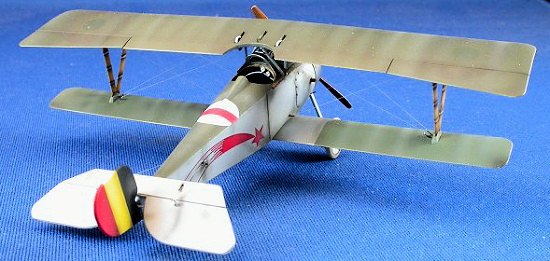 Armament standardized on
the Vickers machine gun, mounted on the fuselage ahead of the cockpit and
synchronized to fire through the propeller. Despite the French preference for
this weapon there were Nieuport 17s and 23s armed only with the above-wing Lewis
gun, while some aircraft equipped with the Vickers also carried the Lewis for
additional firepower.
Armament standardized on
the Vickers machine gun, mounted on the fuselage ahead of the cockpit and
synchronized to fire through the propeller. Despite the French preference for
this weapon there were Nieuport 17s and 23s armed only with the above-wing Lewis
gun, while some aircraft equipped with the Vickers also carried the Lewis for
additional firepower.
The Nieuport 23 - which appeared in early 1917 - differed from the Nieuport 17 had a later form of interrupter gear for the Vickers machine gun, which was mounted a few centimeters to the right on the forward fuselage to fit with the new cam system of the interrupter gear. Additionally, the Nieuport 23 was powered by the 120 h.p. Le Rhone 9Jb, providing a slightly superior performance to the Nieuport 17. French Escadrilles used the Nieuport 17 and 23 interchangeably in service.
The airplanes were also used by the Royal Flying Corps and the Royal Naval Air Service - where they were armed with Lewis guns on Foster mounts - and by the Belgian Air Force and the Imperial Russian Air Service. By the end of the summer of 1917, the day of the Nieuport sesquiplane was over on the Western Front.
| THE KIT |
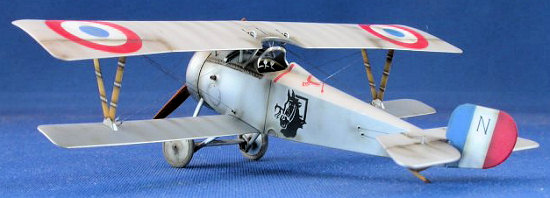 This is Eduard’s third
release of their 1:72 Nieuport Ni-17 molds, this time in Ni-23 guise. The
spruce are exactly the same for all releases. Two complete kits with four
marking options and two Photo Etched sets are included.
This is Eduard’s third
release of their 1:72 Nieuport Ni-17 molds, this time in Ni-23 guise. The
spruce are exactly the same for all releases. Two complete kits with four
marking options and two Photo Etched sets are included.
(To get an idea of what the kit is really like, visit Bill Michaels' very nice preview. Ed)
| CONSTRUCTION |
I chose to build both supplied kits, one mostly OTB (A), while the other built with added detail and improvements (B).
Eduard supplies P.E. detail parts for the cockpit interiors including structure
framing, seat, throttle controls, lap belts and
 instruments. Build “A” did
receive the P.E. seat, instruments and lap belts, build “B“, all of the
included P.E.
instruments. Build “A” did
receive the P.E. seat, instruments and lap belts, build “B“, all of the
included P.E.
Interiors were painted with Floquil lacquer Foundation then a wash of raw umber artist oils was used to obtain the wood finish.
I opened up the holes in the horizontal stabilizers for the control wires to pass through. The molded in exhaust pipes were also drilled out.
Nieuport Ni-23 cowlings had oblong cooling vents in them which Eduard chose to ignore. I created a template out of dymo labeling tape to help me cut out these vents in build “B”. I gouged the cowling with a scalpel blade, then sanded it smooth to give it a worn and dented appearance.
To get a more candid appearance I cut out and repositioned the control surfaces on build “B”.
I found Eduard’s 1:72 Nieuport one of the easiest WWI aircraft models I’ve ever built. Owing to it’s simple paint scheme of basically overall silver dope I assembled to most of the airframe, minus the top wing, before painting.
I used .002” monofilament from Dia-Riki to rig the models. To aid in the process I used P.E. turnbuckles and control horns from the Eduard set # 72-438.
| COLORS & MARKINGS |
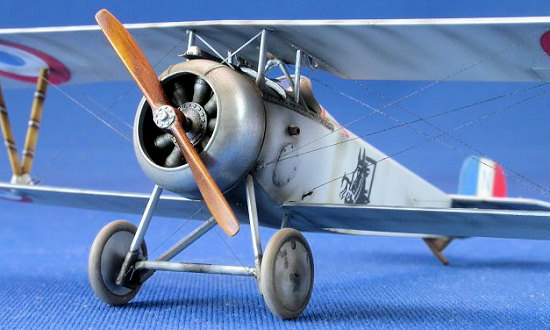 For build “A” I chose the
markings for a Ni-23 flown by Kibanov of the Russian Imperial AF, October 1917.
He was sent to France to gain experience, hence the French National markings.
For build “A” I chose the
markings for a Ni-23 flown by Kibanov of the Russian Imperial AF, October 1917.
He was sent to France to gain experience, hence the French National markings.
After priming the model with Mr. Surfacer 1200, I sprayed it with Mr. Color Silver #CL8. I find this paint to represent silver dope extremely well because of it‘s fine grain. To replicate the natural metal of the cowling I dry brushed it with Mr. Metal Color Stainless Steel #213. It’s actually more of a scrub then a dry brush.
Decals were applied directly to the Mr. Color Silver. I have found the Decals supplied in Eduard’s current kits to be the best performing decals I’ve ever used. In most cases no setting or solvent solutions are needed to get them to settle down into molded detail.
Details were painted with Vallejo acrylics. The Propellers were painted using the same method I used to paint the interior. The entire model, except the cowling, was over sprayed with Mr. Hobby Flat Clear.
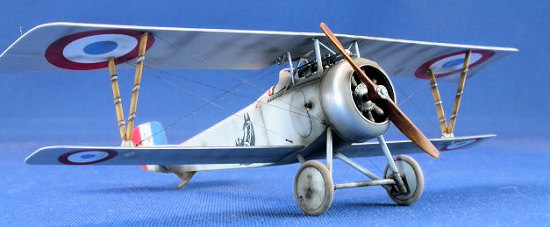 I weathered the model with
streaks of dark and light grays for the silver dope and a post shade of very
thin mix of Tamiya brown and black for dirt, grime and exhaust stains.
I weathered the model with
streaks of dark and light grays for the silver dope and a post shade of very
thin mix of Tamiya brown and black for dirt, grime and exhaust stains.
For Build “B” I chose the markings for a Ni-23 flown by Adjutant Edmonde Thieffry, 5. Escadrille ’Comet’, Belgium, Summer, 1917.
I followed the same method of finish as with Build “A”. The only deviance was painting the upper surfaces of the wings and fuselage with Gunze H320 JASDF Dark Green. To replicate the over painted upper wing Roundels I first painted the Belgium Roundels using masks cut out of Tamiya Masking Tape, then applied the upper surface green.
| CONCLUSIONS |
Eduard’s 1:72 Nieuport fighters are little jewels. Even if the supplied P.E. parts are not used, an accurate and detailed model can be produced.
| REFERENCES |
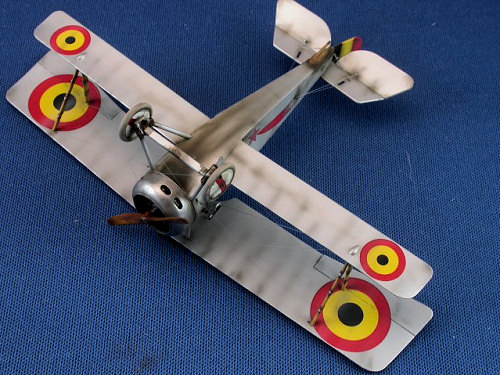 Nieuport Aces of World War 1,
Norman Franks, Osprey Publishing 2000, ISBN 1 85532 961 1
Nieuport Aces of World War 1,
Norman Franks, Osprey Publishing 2000, ISBN 1 85532 961 1
Nieuport Fighters, A Windsock Datafile Special, J.M. Bruce, Albatros Productions, Ltd. 1993, ISBN 0 948414 54 5
Roger Fabrocini
January 2008
Copyright ModelingMadness.com
Thanks to Eduard for the review kit.
If you would like your product reviewed fairly and fairly quickly, please contact the editor or see other details in the Note to Contributors.